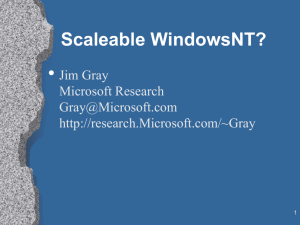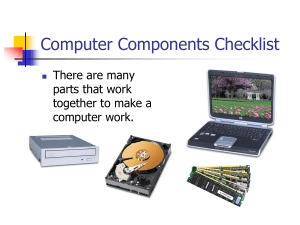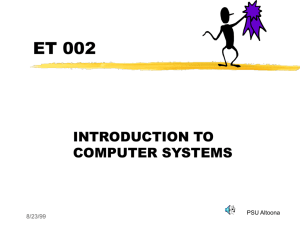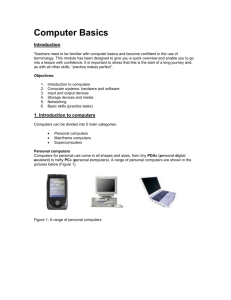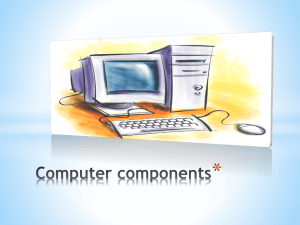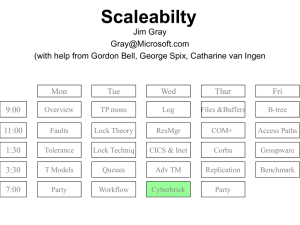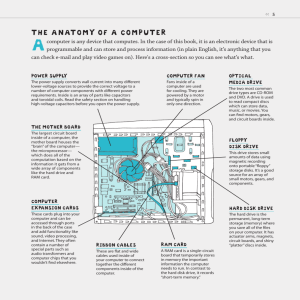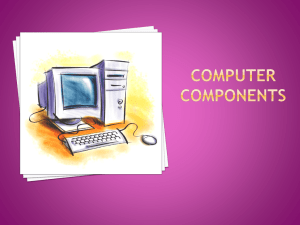Intel_Dupont.
advertisement
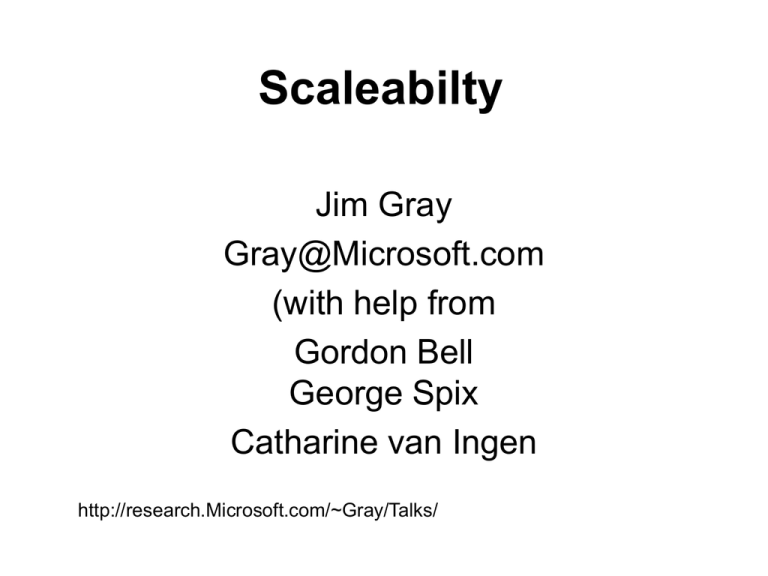
Scaleabilty Jim Gray Gray@Microsoft.com (with help from Gordon Bell George Spix Catharine van Ingen http://research.Microsoft.com/~Gray/Talks/ Scaleability Scale Up and Scale Out Grow Up with SMP 4xP6 is now standard SMP Super Server Grow Out with Cluster Cluster has inexpensive parts Departmental Server Personal System Cluster of PCs There'll be Billions Trillions Of Clients • Every device will be “intelligent” • Doors, rooms, cars… • Computing will be ubiquitous Trillions Billions Of Clients Need Millions Of Servers Billions All clients networked to servers May be nomadic or on-demand Fast clients want faster servers Servers provide Shared Data Control Coordination Communication Clients Mobile clients Fixed clients Servers Server Super server Thesis Many little beat few big $1 million 3 1 MM $100 K $10 K Micro 1 MB Mini Mainframe Pico Processor Nano 10 pico-second ram 10 nano-second ram 100 MB 10 GB 10 microsecond ram 1 TB 14" 9" 5.25" 3.5" 2.5" 1.8" 10 millisecond disc 100 TB 10 second tape archive Smoking, hairy golf ball How to connect the many little parts? How to program the many little parts? Fault tolerance & Management? 1 M SPECmarks, 1TFLOP 106 clocks to bulk ram Event-horizon on chip VM reincarnated Multi-program cache, On-Chip SMP 4 B PC’s (1 Bips, .1GB dram, 10 GB disk 1 Gbps Net, B=G) The Bricks of Cyberspace • Cost 1,000 $ • Come with – NT – DBMS – High speed Net – System management – GUI / OOUI – Tools • Compatible with everyone else • CyberBricks Kilo Mega Giga Tera Peta Exa Computers shrink to a point • Disks 100x in 10 years 2 TB 3.5” drive • Shrink to 1” is 200GB • Disk is super computer! Zetta Yotta • This is already true of printers and “terminals” Systems 30 Years Ago • MegaBuck per Mega Instruction Per Second (mips) • MegaBuck per MegaByte • Sys Admin & Data Admin per MegaBuck Disks of 30 Years Ago • 10 MB • Failed every few weeks • • • • 1988: IBM DB2 + CICS Mainframe 65 tps IBM 4391 Simulated network of 800 clients 2m$ computer Staff of 6 to do benchmark 2 x 3725 network controllers Refrigerator-sized CPU 16 GB disk farm 4 x 8 x .5GB 1987: Tandem Mini @ 256 tps • 14 M$ computer (Tandem) • A dozen people (1.8M$/y) • False floor, 2 rooms of machines 32 node processor array Admin expert Performance Hardware experts expert Network expert Auditor Manager Simulate 25,600 clients 40 GB disk array (80 drives) DB expert OS expert 1997: 9 years later 1 Person and 1 box = 1250 tps • • • • 1 Breadbox ~ 5x 1987 machine room 23 GB is hand-held One person does all the work Cost/tps is 100,000x less 5 micro dollars per transaction Hardware expert OS expert Net expert DB expert App expert 4x200 Mhz cpu 1/2 GB DRAM 12 x 4GB disk 3 x7 x 4GB disk arrays What Happened? Where did the 100,000x come from? • • • • Moore’s law: 100X (at most) Software improvements: 10X (at most) Commodity Pricing: 100X (at least) Total 100,000X • 100x from commodity – (DBMS was 100K$ to start: now 1k$ to start – IBM 390 MIPS is 7.5K$ today – Intel MIPS is 10$ today – Commodity disk is 50$/GB vs 1,500$/GB – ... time Web & server farms, server consolidation / sqft http://www.exodus.com (charges by mbps times sqft) SGI O2K UE10K DELL 6350 Cray T3E IBM SP2 PoPC cpus 2.1 4.7 7.0 4.7 5.0 13.3 specint 29.0 60.5 132.7 79.3 72.3 253.3 ram 4.1 4.7 7.0 0.6 5.0 6.8 disks 1.3 0.5 5.2 0.0 2.5 13.3 per sqft Standard package, full height, fully populated, 3.5” disks HP, DELL, Compaq are trading places wrt rack mount lead PoPC – Celeron NLX shoeboxes – 1000 nodes in 48 (24x2) sq ft. $650K from Arrow (3yr warrantee!) on chip at speed L2 gb Application Taxonomy Technical General purpose, nonparallelizable codes PCs have it! Vectorizable Vectorizable & //able (Supers & small DSMs) Hand tuned, one-of MPP course grain MPP embarrassingly // (Clusters of PCs) Commercial If central control & rich then IBM or large SMPs else PC Clusters Database Database/TP Web Host Stream Audio/Video 10x every 5 years, 100x every 10 (1000x in 20 if SC) Except --- memory & IO bandwidth Peta scale w/ traditional balance 2000 2010 1 PIPS processors 1015 ips 10 PB of DRAM 106 cpus @109 ips 108 chips @107 bytes 104 cpus @1011 ips 106 chips @109 bytes 108 disks 107 Bps 105 disks 1010 B 107 disks 108 Bps 107 tapes 1010 B 105 tapes 1012 B 10 PBps memory bandwidth 1 PBps IO bandwidth 100 PB of disk storage 10 EB of tape storage 103 disks 1012 B “ market for maybe five computers. ” I think there is a world Thomas Watson Senior, Chairman of IBM, 1943 Microsoft.com: ~150x4 nodes: a crowd Building 11 Staging Servers (7) Ave CFG:4xP6, Internal WWW Ave CFG:4xP5, 512 RAM, 30 GB HD FTP Servers Ave CFG:4xP5, 512 RAM, Download 30 GB HD Replication SQLNet Feeder LAN Router Live SQL Servers MOSWest Admin LAN Live SQL Server www.microsoft.com (4) register.microsoft.com (2) Ave CFG:4xP6, Ave CFG:4xP6, 512 RAM, 160 GB HD Ave Cost:$83K FY98 Fcst:12 Ave CFG:4xP6, 512 RAM, 50 GB HD www.microsoft.com (4) premium.microsoft.com (2) home.microsoft.com (3) FDDI Ring (MIS2) cdm.microsoft.com (1) Ave CFG:4xP6, 512 RAM, 30 GB HD Ave Cost:$28K FY98 Fcst:7 Ave CFG:4xP6, 256 RAM, 30 GB HD Ave Cost:$25K FY98 Fcst:2 Router Router msid.msn.com (1) premium.microsoft.com (1) FDDI Ring (MIS3) www.microsoft.com premium.microsoft.com (3) (1) Ave CFG:4xP6, Ave CFG:4xP6, 512 RAM, 30 GB HD 512 RAM, 50 GB HD FTP Download Server (1) HTTP Download Servers (2) SQL SERVERS (2) Ave CFG:4xP6, 512 RAM, 160 GB HD msid.msn.com (1) Switched Ethernet search.microsoft.com (2) Router Internet Secondary Gigaswitch support.microsoft.com search.microsoft.com (1) (3) Router support.microsoft.com (2) Ave CFG:4xP6, 512 RAM, 30 GB HD 13 DS3 (45 Mb/Sec Each) Ave CFG:4xP5, 512 RAM, 30 GB HD register.microsoft.com (2) register.microsoft.com (1) (100Mb/Sec Each) Router FTP.microsoft.com (3) msid.msn.com (1) 2 OC3 Primary Gigaswitch Router Ave CFG:4xP5, 256 RAM, 20 GB HD register.msn.com (2) search.microsoft.com (1) Japan Data Center Internet Router home.microsoft.com (2) Switched Ethernet Router Router www.microsoft.com (3) FTP Download Server (1) activex.microsoft.com (2) Ave CFG:4xP6, 512 RAM, 30 GB HD Ave CFG:4xP5, 256 RAM, 12 GB HD SQL SERVERS (2) Ave CFG:4xP6, 512 RAM, 160 GB HD Router Ave CFG:4xP6 512 RAM 28 GB HD FDDI Ring (MIS1) 512 RAM, 30 GB HD msid.msn.com (1) search.microsoft.com (3) home.microsoft.com (4) Ave CFG:4xP6, 1 GB RAM, 160 GB HD Ave Cost:$83K FY98 Fcst:2 msid.msn.com (1) 512 RAM, 30 GB HD Ave CFG:4xP6, 512 RAM, 50 GB HD Ave CFG:4xP6, 512 RAM, 30 GB HD www.microsoft.com premium.microsoft.com (1) Ave CFG:4xP6, Ave CFG:4xP6,(3) 512 RAM, 50 GB HD SQL Consolidators DMZ Staging Servers Router SQL Reporting Ave CFG:4xP6, 512 RAM, 160 GB HD European Data Center IDC Staging Servers MOSWest www.microsoft.com (5) Internet FDDI Ring (MIS4) home.microsoft.com (5) 2 Ethernet (100 Mb/Sec Each) HotMail: ~400 Computers Crowd DB Clusters (crowds) • 16-node Cluster – 64 cpus – 2 TB of disk – Decision support • 45-node Cluster – – – – 140 cpus 14 GB DRAM 4 TB RAID disk OLTP (Debit Credit) • 1 B tpd (14 k tps) The Microsoft TerraServer Hardware • • • • Compaq AlphaServer 8400 8x400Mhz Alpha cpus 10 GB DRAM 324 9.2 GB StorageWorks Disks – 3 TB raw, 2.4 TB of RAID5 • STK 9710 tape robot (4 TB) • WindowsNT 4 EE, SQL Server 7.0 TerraServer: Lots of Web Hits 35 Total 71 Average Peak Sessions 30 29 m 18 m 15 m 6.6 m 76 k 125 k Hit 25 Page View Count Hits 1,065 m 8.1 m Queries 877 m 6.7 m Images 742 m 5.6m Page Views 170 m 1.3 m Users 6.4 m 48 k Sessions 10 m 77 k 20 DB Query 15 Image 10 5 0 Date • • • • A billion web hits! 1 TB, largest SQL DB on the Web 100 Qps average, 1,000 Qps peak 877 M SQL queries so far SQL 7 TerraServer Availability • Operating for 4 months: 3,133 hrs • Unscheduled outage: 36.5 minutes: 99.9905% scheduled up • Scheduled outage: 60 minutes • Availability: 99.96% overall up Down Time (Hours:minutes) TotalTime (Hours) 2880 2:30 • No NT failures (ever) 2160 • One SQL7 Beta2 bug • No failures in July, Aug, Oct, Dec, Jan, Feb 1440 2:00 1:30 Up Scheduled 1:00 720 0:30 Un Scheduled 0 0:00 Configuration StorageTek TimberWolf 9710 DEC StorageWorks UltraSCSI Raid-5 Array Legato Networker PowerEdition 4.4a Windows NT Server Enterprise Edition 4.0 Backup / Restore • Performance Data Bytes Backed Up Total Time Number of Tapes Consumed Total Tape Drives Data ThroughPut Average ThroughPut Per Device Average Throughput Per Device NTFS Logical Volumes 1.2 7.25 27 10 168 16.8 4.97 2 TB Hours tapes drives GB/Hour GB/Hour MB/Sec Windows NT Versus UNIX 90,000 80,000 70,000 60,000 50,000 40,000 30,000 20,000 10,000 0 tpmC vs Time 100,000 tpmC vs Time Unix Unix tpmC tpmC Best Results on an SMP: SemiLog plot shows 3x (2 year) lead by UNIX Does not show Oracle/Alpha Cluster at 100,000 tpmC All these numbers are off-scale huge (20,000 active users?) h h 10,000 NT NT Jan-95 Jan-96 Jan-97 Jan-98 Jan-99 1,000 Jan-95 Jan-96 Jan-97 Jan-98 Jan-99 TPC C Improvements (MS SQL) 40% hardware, 100% software, 250%/year on Price, 100% PC Technology 100%/year performance bottleneck is 3GB address space $1,000 $/tpmC vs time 100,000 tpmC vs time tpmC $/tpmC 10,000 $100 1,000 1.5 2.755676 $10 Jan-94 Jan-95 Jan-96 Jan-97 Jan-98 Dec-98 100 Jan-94 Jan-95 Jan-96 Jan-97 Jan-98 Dec-98 UNIX (dis) Economy Of Scale tpmC/k$ 50 45 40 MS SQL Server Bang for the Buck tpmC/K$ 35 30 25 20 15 10 5 0 Sybase Oracle Informix 0 10,000 20,000 30,000 tpmC 40,000 50,000 60,000 Oracle/NT • Compaq /NT/Oracle – – – – 27,383 tpmC 71.50 $/tpmC 4 x 6 cpus 384 disks =2.7 TB TPC Price/tpmC Sun Oracle 52 k tpmC @ 134$/tpmC 50 45 HP+ NT4 +SQL Server 16.2 ktpmC @ 33$/tpmC 45 40 35 35 30 30 25 20 17 15 10 12 8 7 5 4 5 3 0 processor disk software net total/10 Oracle: Soak the Rich: 36% software tax Microsoft: 4% software TPC Price/tpmC 70 61 60 53 50 47 Sequent/Oracle 89 k tpmC @ 170$/tpmC Sun Oracle 52 k tpmC @ 134$/tpmC 45 HP+NT4+MS SQL 16.2 ktpmC @ 33$/tpmC 40 35 30 30 20 10 17.0 17 9 8 4 12 7 5 3 0 processor disk software net total/10 Storage Latency: How far away is the data? 109 Andromeda Tape /Optical Robot 106 Disk 100 10 2 1 Memory On Board Cache On Chip Cache Registers 2,000 Years Pluto Los Angeles 2 Years 1.5 hr This Resort 10 min This Room My Head 1 min Thesis: Performance =Storage Accesses not Instructions Executed • In the “old days” we counted instructions and IO’s • Now we count memory references • Processors wait most of the time Where the time goes: clock ticks used by AlphaSort Components Sort Disc Wait Disc Wait Sort OS Memory Wait B-Cache Data Miss I-Cache Miss D-Cache Miss Storage Hierarchy (10 levels) Registers, Cache L1, L2 Main (1, 2, 3 if nUMA). Disk (1 (cached), 2) Tape (1 (mounted), 2) Bottleneck Analysis • Drawn to linear scale Disk R/W ~9MBps Memory MemCopy Read/Write ~50 MBps ~150 MBps Theoretical Bus Bandwidth 422MBps = 66 Mhz x 64 bits Bottleneck Analysis • NTFS Read/Write • 18 Ultra 3 SCSI on 4 strings (2x4 and 2x5) 3 PCI 64 ~ 155 MBps Unbuffered read (175 raw) ~ 95 MBps Unbuffered write Good, but 10x down from our UNIX brethren (SGI, SUN) Adapter ~70 MBps Adapter PCI ~110 MBps Memory Read/Write ~250 MBps Adapter PCI Adapter PennySort • Hardware – 266 Mhz Intel PPro – 64 MB SDRAM (10ns) – Dual Fujitsu DMA 3.2GB EIDE disks • Software – NT workstation 4.3 – NT 5 sort • Performance PennySort Machine (1107$ ) Disk 25% – sort 15 M 100-byte records (~1.5 GB) board 13% – Disk to disk – elapsed time 820 sec • cpu time = 404 sec Cabinet + Assembly 7% Memory 8% Other 22% Network, Video, floppy 9% Software 6% cpu 32% Sandia/Compaq/ServerNet/NT Sort • Sort 1.1 Terabyte (13 Billion records) in 47 minutes • 68 nodes (dual 450 Mhz processors) Compaq Proliant 1850R Server 2 400 MHz CPUs To X Fabric 543 disks, 1.5 M$ • 1.2 GBps network rap (2.8 GBps pap) • 5.2 GBps of disk rap (same as pap) • (rap=real application performance, pap= peak advertised performance) To Y fabric 6-port ServerNet I crossbar sw itch 512 MB SDRAM PCI Bus ServerNet I dual-ported PCI NIC 4 SCSI busses, each with 2 data disks Bisection Line (Each switch on this line adds 3 links to bisection width) X Fabric (10 bidirectional bisection links) Y Fabric (14 bidirectional bisection links) 6-port ServerNet I crossbar sw itch The 72-Node 48-Switch ServerNet-I Topology Deployed at Sandia National Labs SP sort 4.0 • 2 – 4 GBps! 3.5 GPFS read GPFS write 3.0 Local read Local write GB/s 2.5 2.0 1.5 1.0 0.5 0.0 0 100 200 300 400 500 600 700 800 900 Elapsed time (seconds) 56 nodes 18 racks Storage 432 nodes 37 racks compute 488 nodes 55 racks 1952 processors, 732 GB RAM, 2168 disks 56 storage nodes manage 1680 4GB disks 336 4+P twin tail RAID5 arrays (30/node) Compute rack: 16 nodes, each has 4x332Mhz PowerPC604e 1.5 GB RAM 1 32x33 PCI bus 9 GB scsi disk 150MBps full duplex SP switch Storage rack: 8 nodes, each has 4x332Mhz PowerPC604e 1.5 GB RAM 3 32x33 PCI bus 30x4 GB scsi disk (4+1 RAID5) 150MBps full duplex SP switch Progress on Sorting: NT now leads both price and performance • Speedup comes from Moore’s law 40%/year • Processor/Disk/Network arrays: 60%/year (this is a software speedup). SPsort 1.E+08 Sort Re cords/se cond vs T ime SPsort/ IB 1.E+07 1.E+06 Records Sorted per Second Doubles Every Year NOW IBM RS6000 1.E+06 IBM 3090 Sandia/Compaq /NT Ordinal+SGI NT/PennySort Alpha Compaq/NT 1.E+03 1.E+05 Cray YMP Sequent 1.E+04 1.E+03 Intel HyperCube Penny NT sort 1.E+00 Kitsuregawa Hardware Sorter Tandem 1.E+02 1985 GB Sorted per Dollar Doubles Every Year Bitton M68000 1990 1995 2000 1.E-03 1985 1990 1995 2000 Recent Results • NOW Sort: 9 GB on a cluster of 100 UltraSparcs in 1 minute • MilleniumSort: 16x Dell NT cluster: 100 MB in 1.18 Sec (Datamation) • Tandem/Sandia Sort: 68 CPU ServerNet 1 TB in 47 minutes • IBM SPsort 408 nodes, 1952 cpu 2168 disks 17.6 minutes = 1057sec (all for 1/3 of 94M$, slice price is 64k$ for 4cpu, 2GB ram, 6 9GB disks + interconnect Data Gravity Processing Moves to Transducers • Move Processing to data sources • Move to where the power (and sheet metal) is • Processor in – Modem – Display – Microphones (speech recognition) & cameras (vision) – Storage: Data storage and analysis • System is “distributed” (a cluster/mob) SAN: Standard Interconnect Gbps SAN: 110 MBps PCI: 70 MBps UW Scsi: 40 MBps FW scsi: 20 MBps scsi: 5 MBps • LAN faster than memory bus? • • • • 1 GBps links in lab. 100$ port cost soon Port is computer Winsock: 110 MBps (10% cpu utilization at each end) Disk = Node • • • • has magnetic storage (100 GB?) has processor & DRAM has SAN attachment has execution Applications environment Services DBMS RPC, ... File System SAN driver Disk driver OS Kernel end
